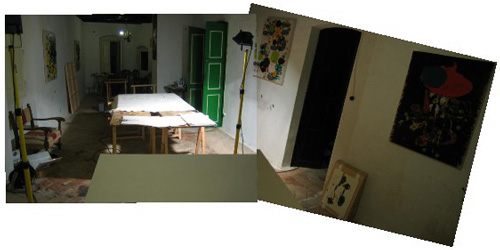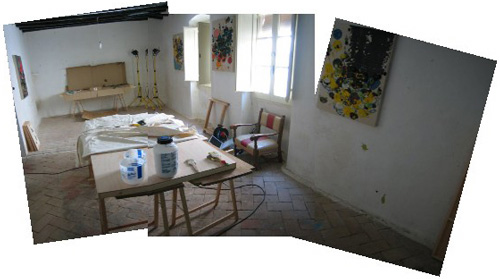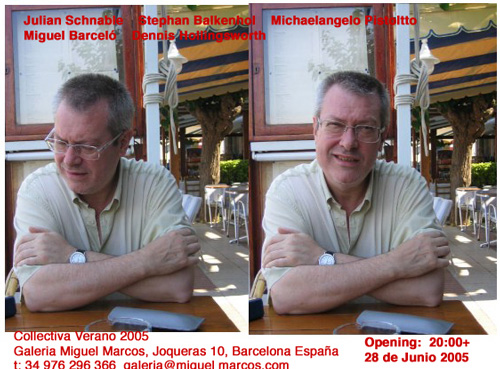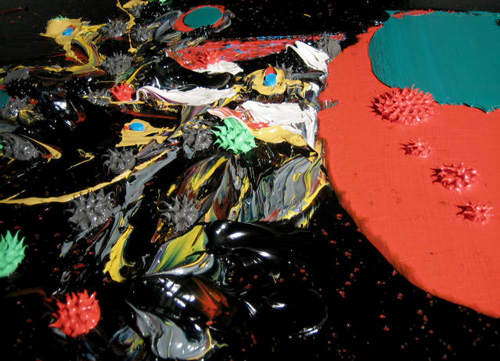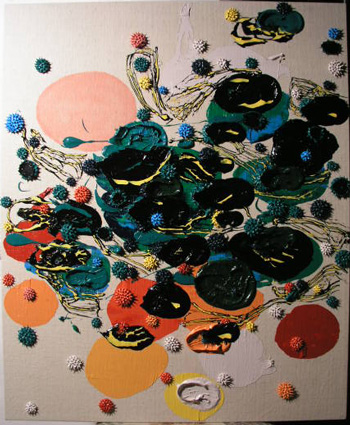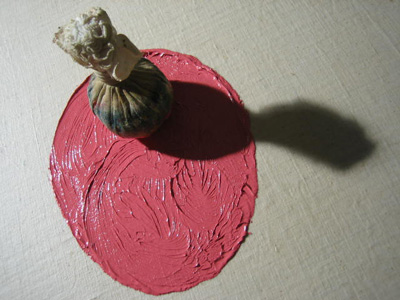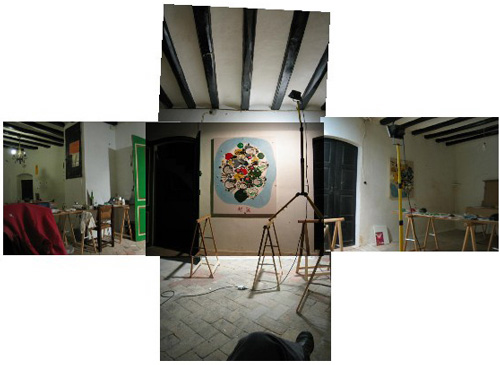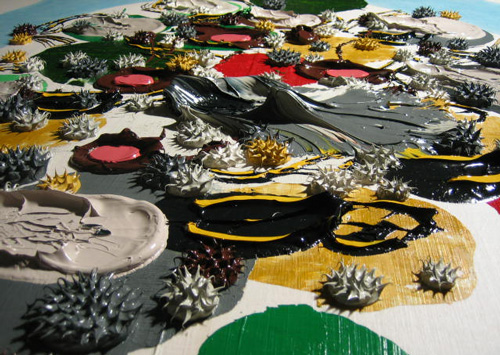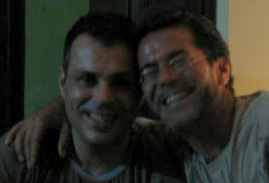June 28, 2005
June 27, 2005
Maker, Doer.
...how about those two paragons of reason and rectitude ? Aristotle and St. Thomas Aquinas? They provide a philosophical basis for Wilde's position by distinguishing between two types of human action: making and doing.
Doing involves human choices, the way we exercise our free will. In the realm of doing ? or Prudence, as it has been called ? the goal is the perfection of the doer. In other words, in our behavior we are seeking to perfect ourselves as moral agents. But in making ? or Art, if you will ? the end is not the good of the artist as a person but the good of the made thing. The moment that art is made subservient to some ethical or political purpose, it ceases to be art and becomes propaganda.
Art seems to require an inviolable freedom to seek the good of the artifact, without either overt or covert messages being forced into it. And history demonstrates that it is simply a statement of fact (to paraphrase Aquinas) that rectitude of the appetites is not a prerequisite for the ability to make beautiful objects. Thus our poisoner with his exquisite prose style. Or Picasso brutalizing the women in his life. Or the legion of artists and scientists who drank or drugged themselves to death.
Of course, the opposite must also be true: that being an jerk won't make you a great genius. I've known a few artists in my time who've tried and failed at that. And as far as propaganda goes, I was educated in an era that thought it could morally improve the world with the art object. I'm not entirely sure that we've shaken that off yet.
The conclusions in this essay are subtle and interesting. Be sure to find the links at the tail end too.
(image: the battle cry of Juan Carlos)
Weekend Report

Gerry and Paul invited me to critique their urbanism/travel abroad studio -now in Barcelona then Berlin then Paris.
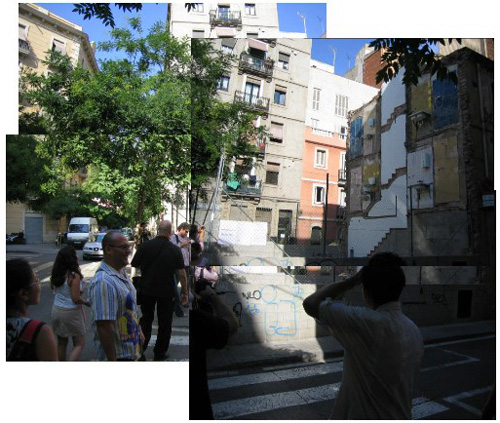
In all three cities the students intutively select different aspects of the city and try to understand the historical conditions that generated them... and then they apply this new found understanding to another site which appears to be in need of improvement within the city, in this case, the Forum.
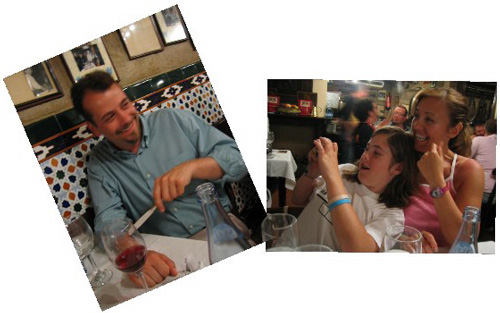
That night, we went into the Barcelona night to eat dinner at Los Caracoles and watch the eve of San Juan for the fireworks rauxa mania madness at the beaches of the Barceloneta. In short: beh. Last year in Tossa was much better (it was like a beach invasion, so intense).. in contrast, this one was weak with the fireworks, crowded and most definitely an intensification of the grime that Barcelona is already known for.
Skanky.
Think the dregs of Woodstock and you are simply not high enough yet.
(Beat, one, two, three...)
Gerry's family was in town and I invited them and Paul to go to Tossa for a proper vacation weekend by the sea. Here are a few shots of the weekend:
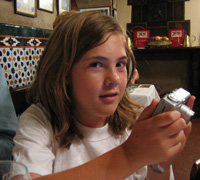
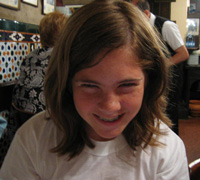
This is Gerry and Claudia's daughter, Natalie. I instructed her in the fine points of posing for portraits via the Tony Cu?ha method. ?Que bien, chica!
She and I hit it off so well that I declared myself her uncle. That weekend, I gave her basic training in snorkeling. She got to see a few marvels underwater here in this part of the Med.

Fast forward past the kayaking through the grottos and cliffs north of here, past the super fantastic dinner that was expensive but still a third of what you would pay for in LA, past the shopping (my first time in the tourist stores really), past the roving-yet-deep art/architecture conversations that lasted until three am... there are no fotos to document that. Wait for the future nanobot retinally implanted -thought controlled -ubiquitous computing -blog every living-moment -en vivo for that kind of detailed blogpost.
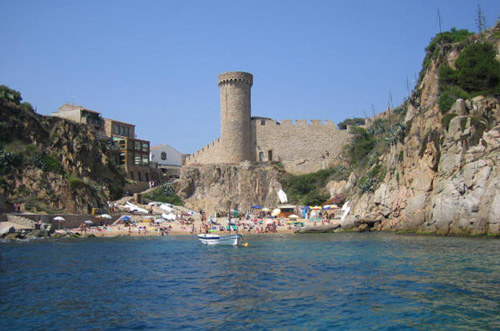
Paul went back and later, Gerry's family returned to Barcelona. I sent them back exhausted from a forced march of fun and diversion, sunburnt, heavy lidded eyes, big smiles and effusing with the slight trace of slurred speech: "You're crazy for leaving Tossa!"
No, we aren't leaving Tossa, we are living (attempting to live) both&between Tossa and LA. Plus, there are nice aspects of LA thankyouverymuch. ( A kindly reminder.) But I was pleased to hear that response nonetheless.
Besides, why do the Bodhisattvas choose to go back?
JUST KIDDING!
So there I was, having just packed my friends off on the bus to Barcelona. I get to resume my studio agenda. I got to the house and I started to put things back together again, to clean up and take a shower and wash the salt off. I set up the fan, jumped into bed and flipped open the laptop to check email... and "ding dong!", the doorbell.
It was Juan Carlos, the police chief who has taken to hanging out from time to time and hablabbing about art and life and things. That, my friends, is a blogpost to come one day. (I know I've promised alot soon to come posts, but the cup runneth over, seriously.). I described the crazy days I've had recently and Juan Carlos is cool enough to take a raincheck. He promised to come to the opening this Tuesday in BCN.
Muy bien, se?or.
I got back into bed, body radiating the heat of the sunburnt day... I flipped open the laptop... "ding dong!" It was Grada. My yankee friends are going back to the states and they wanted to introduce me to Santi, a mysterious neighbor man who plays the guitar in front of his door on the street from time to time... so fantastic. I had to go, I like Meade and Grada alot, and I wanted to meet this mysterious guy, Santi.
Well, I can't go into it... I don't have the time right now for a three hour treatment of that night with Santi, a monkish fellow who eschews all forms of technology and wants to build a cave in the woods and play music (he sang three tunes in Portugese, amazing sensibilities) in a perfect space and read and meditate in silence and astral project and all that.
Yes, astral projection.
That blogpost is gong to be goooooooooooood.
Anyways, that evening ended at three am.
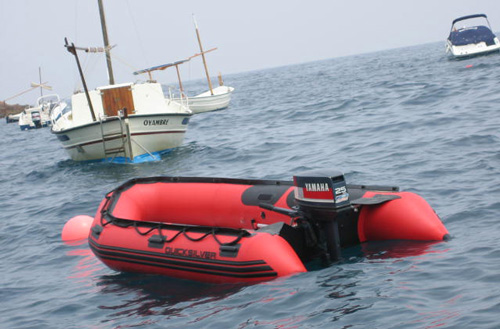
The next day, I call up Kiko for lunch. Kiko got a new boat.
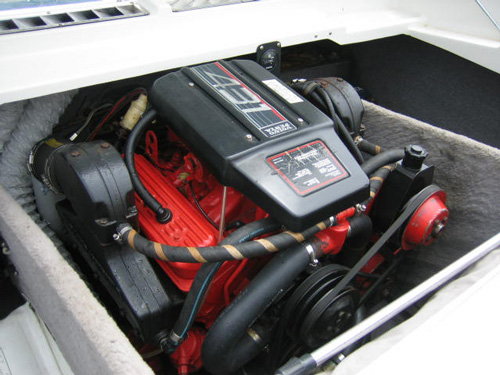
So did Xerlo.

We cruise out along the coast, very bouncy. A quiet engine, fast.
Onboard music system, big speakers. On deck: Bob Marley.
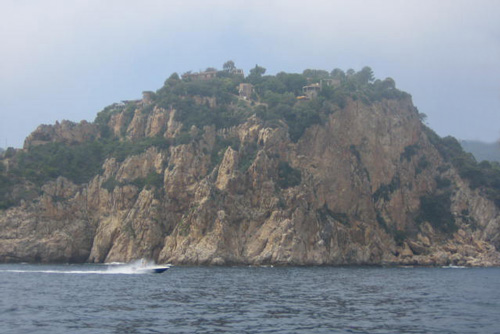
If you can rent a kayak for three hours, you can paddle out to a beachside restaurant that is only accessible by sea. Then you can paddle through the coves and grottos on the way back.
We zoomed up and around in no time flat.
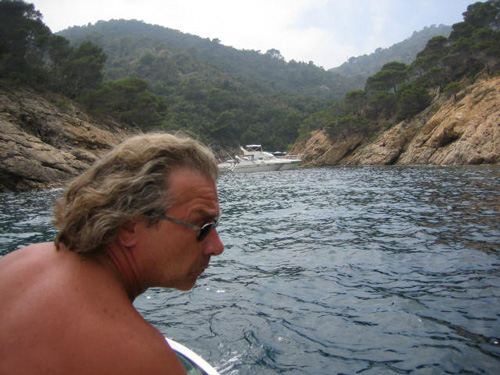
Today, it was too crowded to moor our boat to get in, so we jet south.

We head past Codolar, for the bay that has a nudist beach. Not that we cared to see anything, mind you. Just cruising, hanging out. Kiko and Xerlo, El Capit?n. Maite, Xerlo's wife sat with me in the back seat.
I was going to jump in for a snorkel. Let the water, still cold ("frescita") cool off the solar radiation (now, making Vitamin D is good for us -somewhat like what plants do with chlorophyl), I was looking forward to a refreshing dip.
Then we noticed the jelly fish. Medusas. A horde, tons of them in the water:
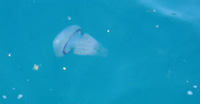
![]()
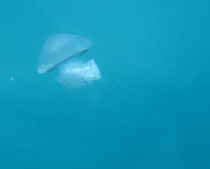
![]()

![]()
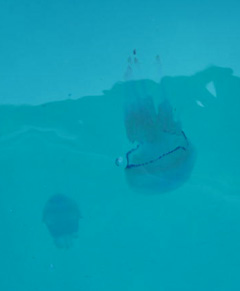
![]()
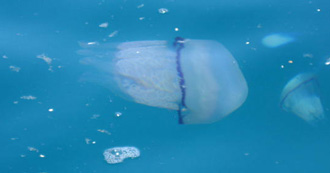
![]()
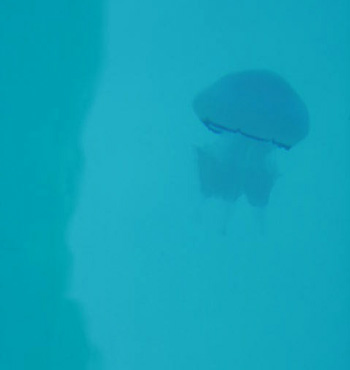
![]()
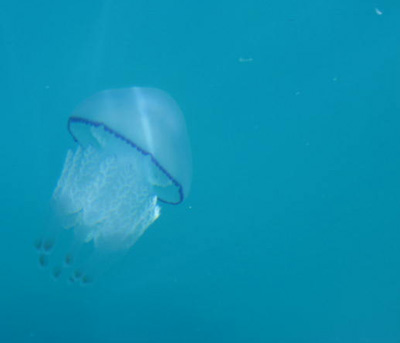
![]()
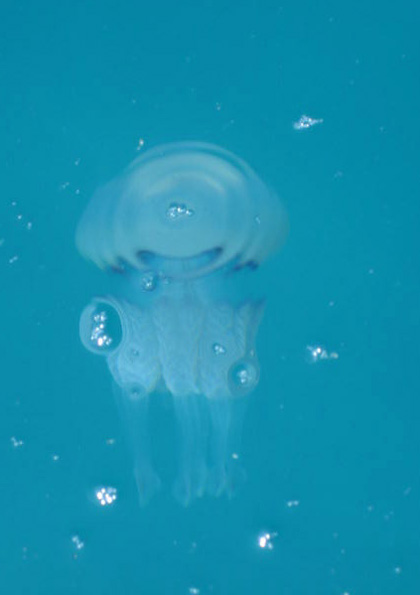
![]()
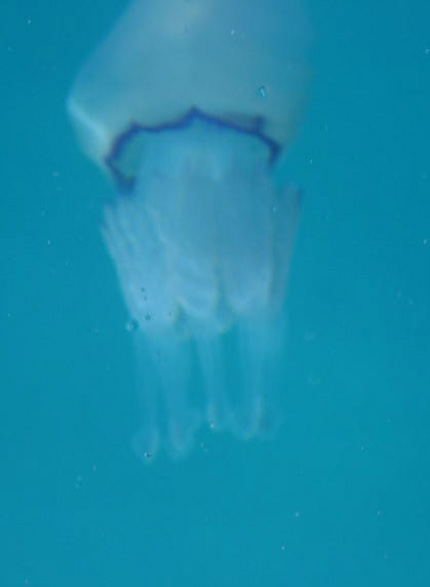
![]()
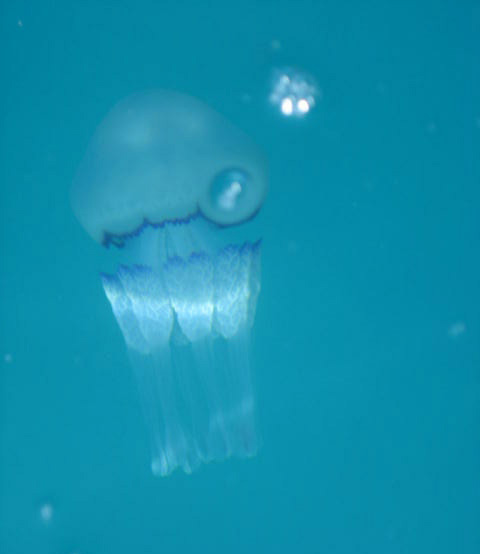
![]()
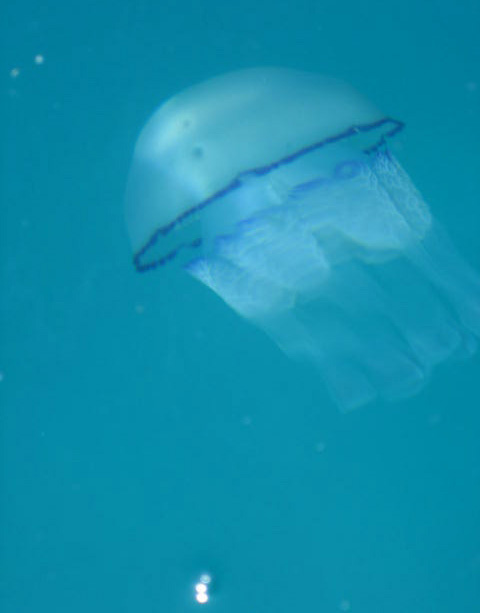
![]()
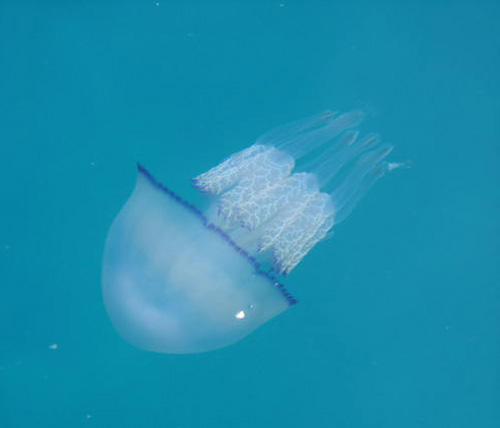
So Beautiful. Look, see how the water glows. Ambient light, a saline lens.
Snorkeling is like plunging into a gemstone.
(Back to the studio.)
June 23, 2005
June 20, 2005
Marcelino Pan y Vino
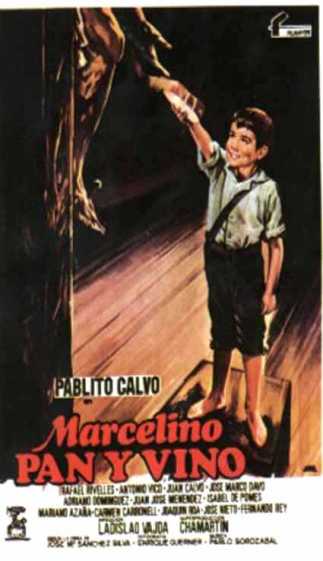
Google is amazing. Simply amazing.
Our house is an old winery (cava, champagne) built in 1706. I see the stones in the walls and imagine what the people might have been like when they lifted them into place, what they were wearing, what the surroundings were like (a vinyard, I bet) so far out from the old walls of the fortified pueblo.
Various occupations included a butcher shop, then a tavern called "Can Marcelino" and then a restaurant called "Tito's, the people we bought it from five years ago. People in town routinely come up to us and tell us stories of their youth when this place was a living room for fishermen, sipping wine and roasting sardines in the fireplace with pan Catalan on the side. Firelight shining up on rustic faces and stories back and forth.
Usually, I would say "Tito's" and townsfolk would sing in response: "Marcelino Pan y Vino!".
As a lark, I typed "Marcelino Pan y Vino" into the search box and lo! This is what I found:
2. It might have been a movie remade a few times over.Described as a masterpiece of classic Mexican cinema, this multi award winning film tells a deeply affecting story about the power of goodness. The use of strong symbolism and haunting imagery sets an undeniable mood: Marcelino, a boy who grows up in a monastery, prepares to eat his daily serving of bread. When he decides to give a statue of Jesus a piece of his small meal the statue accepts his offer and rewards him multifold.
3. It was a movie made in 1955:
This touching film tells the story of a lonely boy who finds solace and friendship in a picture of Christ.
As a baby, Marcelino was abandoned by his parents and placed on the steps of a Franciscan monastery. The friars find him there, and provide the child with food and shelter. Their kindness, however, does not prevent little Marcelino from desiring the friendship of other children. So when he finds an image of Jesus in the attic, his lively imagination transforms the inanimate object into a special friend.
Then Marcelino offers bread and wine to the icon... and suddenly Christ, stirred by the boy's gesture, comes to life...
UPDATE:
Someday, once information technology (computers) become ubiquitous (here, a post describing how it is already happening), a google type search will be at the within our reach/at the tip of our tongues -all the time.
Admin
Strange things are happening under the hood of this blog machine. First, the despamming engine goes out, then the comments won't work, and now: new posts won't load up onto the main page. The only way to see new posts or even this Admin report at the moment -is by clicking the archives. I wouldn't be surprised if this seeming degenerative disease wipes them out.
My webhost is overhauling their system, and maybe that is the source of the problem. But no worries... my peeps are looking into the situation (Old school mate Dean and his wife Glenda, who so generously gifted me with this wonderous contraption in the first place).
UPDATE: I usually surf the net with Safari and Firefox together. The difference between the two is in the use of bookmarks. Safari has the immense library, Firefox is a lean and tightly edited. I opened Explorer to see if the new posts would load up onto the main page and lo! So why is it that different browsers load pages differently?
Expansiveness

A scan thru Arts and Letters Daily leads me back to the "Edge", a site I haven't visited since I first started surfing the web. It's good to find it again.
I like to think that the shallower aspects of the intellectual scene of the last century have played themselves out. I mean in particular the assaults on objectivity and rationality, which often take the form of attacks on science. There's nothing less exhilarating than reducing everything to social constructs and to our piddly human points of view. The pleasure of thinking is in trying to get outside of ourselves?this is as true in the arts and the humanities as in math and the sciences. There's something heroic in the idea of objective knowledge; the farther away knowledge takes you from your own individual point of view, the more heroic it is. Maybe the new ideas that are going to revitalize the arts and humanities are going to be allied with the sciences. It's not, of course, that novels will all address scientific themes?that would be ridiculously restrictive. But I hope that the spirit of expansiveness that's associated with the pursuit of scientific truth can get infused into the arts and humanities.And later on in the piece:
...It's as if a painter produces a picture that has something to say about the nature of beauty, perhaps even something to say about why beauty moves us....
Weekend Report

After the last painting, I had to kick back and see friends, let my hair down a bit, and in not having that conceptual spark that lights up a literary missive this weekend, I thought a tidy little graphic would do the trick.
Food, drink (moderate, no carousel thru the museum of alcohol until five am this time) and conversation, a first plunge into the still-cold summer water, a couple of skin dives (We looked for octopus on the dive -nothing, but many schools of fish, very nice), a nice start on a tan, a midnight party for a local Tossa boy at Codolar beach, Pepa and Joan tried to get me to dance at El Pirata (no dice, dunno why), a nice impromptu lunch from Xerlos's wife Maite and her mother Magda.... another lunch with Kiko, drawing up plans for Carmen's house in Toledo (an impossible plan, so small).
And now, back into the studio for a crack at another small painting.
This week: Miguel will come by Wednesday to pick up the paintings for the show at his gallery in Barcelona; I'll be critiquing Gerry's urban architecture studio in Barcelona on Thursday, Gerry's family might come up to Tossa for the weekend and I've got to stretch the four new panels before the month ends.
Tight but not impossible.
June 17, 2005
June 16, 2005
Stay Hungry. Stay Foolish.
No one wants to die. Even people who want to go to heaven don't want to die to get there. And yet death is the destination we all share. No one has ever escaped it. And that is as it should be, because Death is very likely the single best invention of Life. It is Life's change agent. It clears out the old to make way for the new. Right now the new is you, but someday not too long from now, you will gradually become the old and be cleared away. Sorry to be so dramatic, but it is quite true. Your time is limited, so don't waste it living someone else's life. Don't be trapped by dogma - which is living with the results of other people's thinking. Don't let the noise of other's opinions drown out your own inner voice. And most important, have the courage to follow your heart and intuition. They somehow already know what you truly want to become. Everything else is secondary.
Monk's Dinner
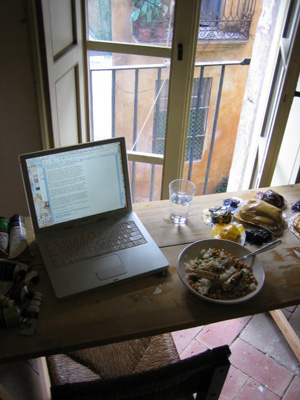
It was a nice moment, so I thought I would try to pluck it to savor later.
I didn't want to leave the studio/house and the cupboard was skimpy. I McGyvered a dinner out of an onion, garbanzo beans, peas, a little rice and sardines. I love pulling a rabbit out of the hat.
Motorcycles pass, children play. Eight thirty and the sky is still has some brightness to it. A petardo goes off now and again in anticipation of Saint Juan's night.
On screen: a selection from Arts and Letter's Daily.
Ahora
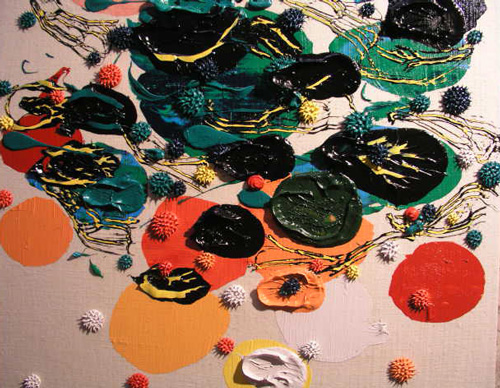
Adentro.

Afuera.
We're having the exterior of the house painted... while I'm painting indoors.
When I went outdoors to see the workers off at the end of the day, this image seemed resonant.
June 15, 2005
The Sleep of Reason
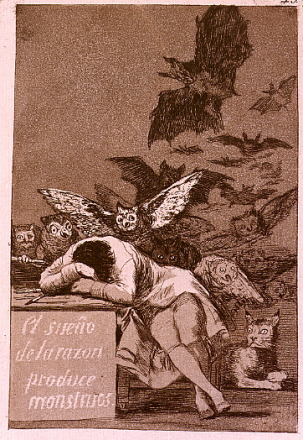
I was fourteen when I first saw the Prado. An exhibition of the Caprichos was up at the time. The experience is vivid to this day.
I was thinking of them -especially the "Sleep of Reason"- in regards to the recent Masson/Bataille post... how the creators of "Acephale" were willing to conjure monsters in the time between wars.
Admin
Brent Hallard was kind enough to give me a heads up concerning the disabled comments function. Recently, I haven't been able to eliminate spam (what tedium, what friction!) and I was wondering why the number of offending agents were frozen at 15,565!
I have mixed feelings about bringing it back up.... one solution is to carve out the offending (diseased?) organ (comment function) and let email function in it's place. The only trouble with that is that visitors can't read the comments unless I post it, adding to my workload. But with the number of comments that I usually get, not a bad option!
However, a blog without comments is not the same community as one with one, an interesting situation.
The other issue is that I depend on my good friend Dean and his wife Glenda to help me troubleshoot problems. I would not like to plague them with these problems after they so generously engineered this blog into being for me in the first place... afflicting altruism with a pest. Trouble is, my research online for getting under the hood of this machine brings back feelings that I haven't felt since my undergraduate days in calculus class.
I've been wondering just how long I can maintain a blog as part of the studio practice. My mind goes back and forth.
Well....
In the meantime, please feel free to substitute email for the comments section:
dennis@dennishollingsworth.us
June 14, 2005
ZARDOZ
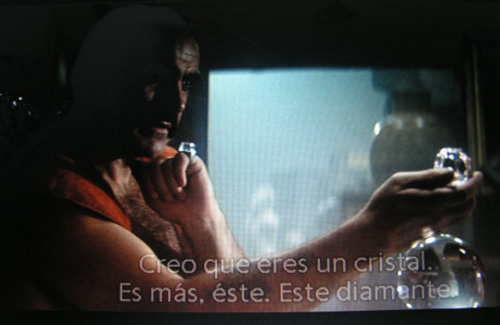
The future imagined by John Borman in the movie Zardoz has moved one step closer:
Years ago, I read a short story by (I think) Greg Egan in which everyone gets a tiny crystal storage device implanted at the base of his or her brain. Via nanotechnology, the crystal is "wired" to the entire brain and is essentially just backing the brain up as it goes, neuron by neuron. In a sense, the crystal is a sort of "warm standby" backup of the brain, the ultimate disaster recovery system.The crsytal is diamond, and thus highly resistant to shock, changes in temperature, etc. So no matter what happens to you, no matter how traumatic, chances are the crystal comes out just fine. So whatever happens to me, I am a restorable entity. Via stem cell technology, they can grow back anything that's missing from my body, up to and including major chunks of brain. Then once my body and brain are whole, they just do a restore from the crystal, and voila!
It's me. Just like before the accident.
I guess that this would be the "cure" for acephalia.
(This is a screenshot of the great unsung John Boorman movie, Zardoz. A film as loved as much as it is mocked. By all means, see it for yourself and choose which side you're on.
June 13, 2005
Acephalia
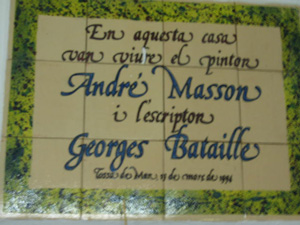
The other night, we dined at a restaurant in front of the walls of the old fortifications of Tossa de Mar. I looked up, and there was a plaque...
...what luck!
I google:
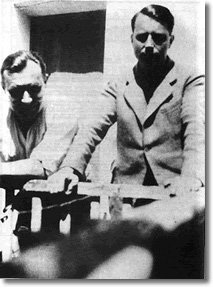
Check this out:
What I have thought or represented, I have not thought or represented alone. I am writing in a little cold house in a village of fishermen: a dog has just barked in the night. My room is next to the kitchen where Andr? Masson is happily moving around and singing; at this very moment, as I write, he has just put on the phonograph a recording of the overture to Don Giovanni; more than anything else, the overture to Don Giovanni ties my lot in life to a challenge that opens me to a rapturous escape from the self. At this very moment, I am watching this acephalic being, this intruder composed of two equally excited obsessions, become the ?Tomb of Don Giovanni.?
Masson and Bataille - Tossa, April 1936
When, a few days ago, I was with Andr? Masson in this kitchen, seated, a glass of wine in my hand, he suddenly talked of his own death and the death of his family, his eyes fixed, suffering, almost screaming that it was necessary for it to become a tender and passionate death, screaming his hatred for a world that weighs down even on death with its employee?s paw?and I was no longer able to doubt that the lot and the infinite tumult of human life were open to those who could no longer exist as empty eye sockets, but as seers swept away by an overwhelming dream they could not own. - Tossa, 29 April 1936 [Stoekl translation]
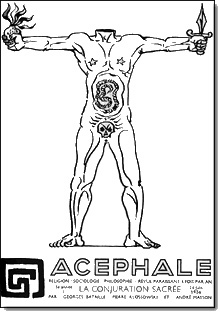
Why acephalia?
What language.
What rapture.
UPDATE I:
I click over to iTunes and buy the overture to Don Giovanni from the music store. As I reply by email to my friend Rabbi Milkblood concerning a mutual project, I think of all my artist friends and what they must be doing this very moment and of all the great times we've had hanging out, talking about art and life. Food and drink and conversations roaming.
Seagulls squawk overhead.
"...not thought or represented alone..." indeed.
UPDATE II:While listening to this, I googled towards the French Revolution and I found this:
Mozart's other operatic masterpiece Don Giovanni, the librettist of which was also Da Ponte, is based on the Spanish theme of Don Juan, which, in various forms, had appeared in literature many times since it first appeared as El Burlador de Sevilla by Tirso de Molina, in 1630. Here the same subject matter that we found in Figaro is dealt with in far more sombre colours, and in greater depth and complexity. The dark colours of this work are evident from the first portentious and threatening bars of the overture. Don Giovanni, like the Count, is a rake, but he is much more than this: he is also a rebel who rejects all social and moral norms. There is an element of anarchy running through this opera, an intuition of the crumbling of the existing social and moral order.
June 10, 2005
Barcelona and Miro
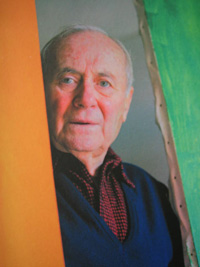
My schedule in the studio can be pretty intense, and after finishing the previous painting (thus fulfilling my commitment to the group show in Barcelona at Miguel Marcos Gallery), I figured that I have a chance to go to Barcelona and see the Miro Museum. My cousin Patricia said that she would like to come along, very good! And to top it off, we met up with my old friend Gerard Smulevich, who is teaching the study abroad program for Woodbury University's school of Architecture.
Serendipitalicious!
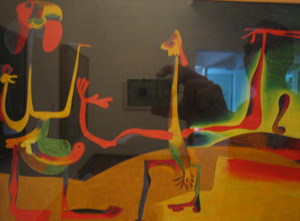
When we got our tickets, the inevitable question about photography arose. Yes, they said, no problem, just make sure you don't use flash. They must have thought: "Suckers!"... because all the paintings had glass to repel fingers (and image snatchers like me, I imagine).
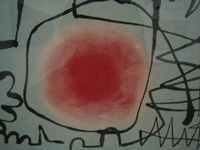
After generating the blue mists in the previous two paintings, I locked onto this kind of detail. Hmmmmmm.
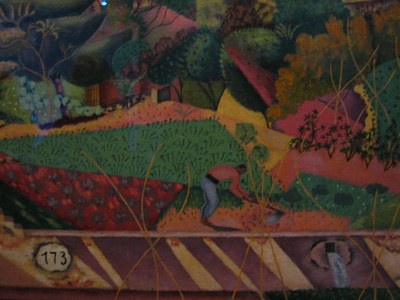
Robert Hughes wrote about Miro's "The Farm, Montroig" in his book, "Barcelona" (I want to reread it before I return to LA). Alas, this is not a detail from that painting... but perhaps it can substitute for it here:
He began to paint it in 1921, in the place itself: the family house, or casa parial, in a small village near Tarragona, south of Barcelona. He then took the unfinished picture, along with a bunch of dired grass from the farm- a fetish of contact with the Catalunya he was about to lose- to Paris. Shifting between lodgings, he lost the grass but replaced it with some from Bois de Boulogne; the picture was too advanced by then for substitution. Miro finished it in Paris in 1922 and eventually sold it to Ernest Hemmingway, who for the rest of his life revered it as his fetish of iberian memory: "It has in it," he wrote, "all that you feel about Spain when you are there and all that you feel when you are away and cannnot go there. No one has been able to paint these two opposing things."
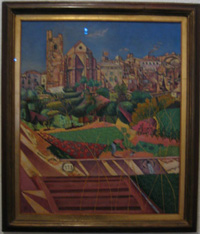
He was right; The Farm is, above all, an expatriate's painting, combining in one image the intense pressure of immediate experience if one's hmeland and an equally extreme longing for it. Everything on the farm is rendered with fidelity: the landscape in the red Tarragonese earth, is rendered with utter fidelity: the landscape is a palace of recollection, a mnemonic device itself. Miro's sense of separation and longing is conveyed by a kind of visual accountancy, an exact toting and tallying of everything that is (or was) the case on the family farm.

It could be a pictorial form of the meticulous inventory that went with peasant marraige contracts. Each tool, pitcher, keg, press, cart, watering can, donkey, dog, chicken, goat, pigeon, and donkey's rump (just visible through the door of the bestier on the ground floor ot the farmhouse) is turned to the light, delineated, listed, fixed. The sharp focus, teh hallucinated clarity of light, make the painting exquisitely frank. But they also produce the effect of looking down the wrong end of a telescope, so that the scene is remote as well...
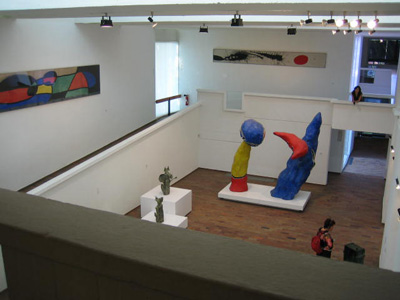
Very nice too, to see the famous Sert building. I hope no one read my post on Tapies as too flip. Like that plate of patatas bravas (see the link), Sert's architecture has (to quote myself, fingers polished on my lapel) "Earthy, particular Catalan earth, fruit of the rich soil of this region... Lavish, rich and saucy. Direct and simple, earnest and elemental."
![]()
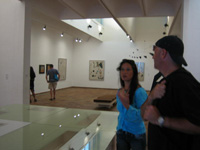
![]()

![]()
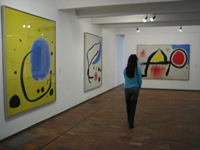
![]()
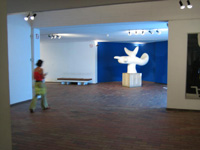
![]()
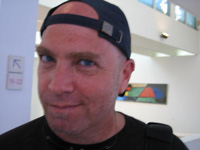
I ask Gerry for a pic and I directed him according to the Tony Cu?ha method. ?Muy bien, tio! He's been shooting a lot of pictures lately, and it flips me out since last we worked together at Woodbury, he was a freak for computers. Now, he's all reverse osmosis technology-wise. For example, check out his discovery of this crazy camera, a "Holga":
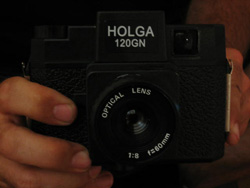
Cheap, medium format, plastic lens, easy to reengineer into other configurations. Gerry is back feeding chemical images through digital media.
Mestizo media. Mongrel technology. Very interesting. I hope to show more of his stuff in this blog later, (especially his design for portable voting stations for Muslims in Afganistan -he and Patricia had a lot to talk about there ).
June 8, 2005
FishEye
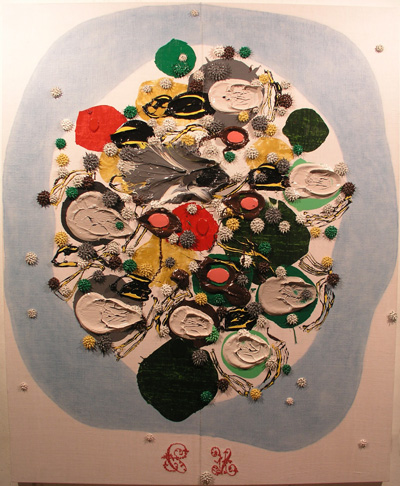
To be honest (yes, let's be honest, Dennis), I don't know why the title "FishEye" popped in my head. I should map the implications:
...that the circular fullness suggests the effect of the distortions that fill the visual field in the way that a fish eye image does. And it reinforces an idea of representation as the generative compositional engine of painting... although the reality of the making of this painting is the reverse of this. But even if that was the way that I had fashioned it (to render an image of a fish eyed world), there's something to the thought of a whole visual field gathered up in a ball, force fitting one schema (a wrap around visual field) into another (the fish eyed ball).
Such a title would provoke a representational interpretation, encouraging a blindness towards the physical dynamics of the painting-as-paint.... and even so, my approach to painting is so physical that there is still no hazard in glossing over the scrum of painterly marks as we make our way towards the imagined image.
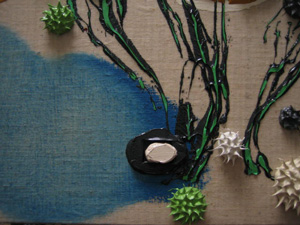
It is this blue surround that is the provocateur. Looking back at the previous work, it is as if a mysterious blue gas was emitted from some kind of chemical reaction.
Here, one might see the history of its making: cerulean blue pressed on and then rubbed off.
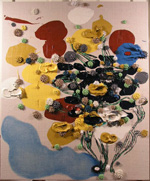
The consequence of welcoming this new element in the mix is choosing how to deploy it. I tend to worry about how I begin a painting (an understatement). I think that the method of entry determines how you arrive at the final result. Maybe this is because of an economy of means, or a quality of elegance or concision that I look for along the way (real or imagined). Failure is a muddle and yet in all of my work process, there is a constant oscillation between the certitude of the executed plan and the bust-out-freaky-wild move that reveals something completely unexpected.
Add to this, the inevitabilty of an eschelon of mark making (those words, "mark" and "mark making"... I'm not so comfortable with them)... by this, I mean that each way I put paint down ("marks") has specific properties that are either enhanced or muted by the subsequent... mark (just go with it, Dennis). Cutting to the chase: imagine trying to lay down a misty blue Casper-like mark after a long train, a scrum of my other moves. It wouldn't be so misty, would it?
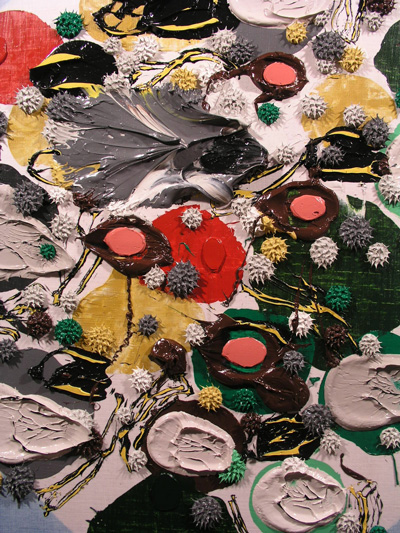
Therefore, there is a linkage and order of possibilities that assemble in train out of all the ways I apply the paint. Each painting requires on average, a week of working time. In each cycle, there is a long intial period of contemplation (that's putting it lightly), then a torrent of actions, then a slowing down to a coasting stop as I steer carefully to a finished painting. Usually, the last segment is all about careful edits that are meant to heighten what gains I had made in the torrent.
The initial phase can twist my stomach into knots. I tend to fret (another understatement which I hope to enlarge in a future blogpost) about the method of entry into the work, being concerned as I am in directing some how, in some way, in any way... the consequences.
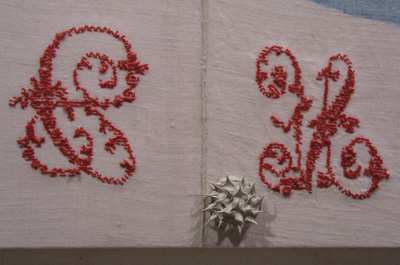
Now, what about this feature, you might ask? I have been using antique linens (the designation antique is a a customs term for goods over a hundred years old). My mother's business involves buying and selling various antique fabrics in Europe and selling them in the states. Over the years, she has shown me these domestic linens from Catalunya (Spain and France) and since I had been working with art store Belgian linen for several years, I was intersted in busting up the pattern (of the dark brown ground), perhaps going back to cotton duck. I like the linen weave, the light warm color, the evidence of human hands in the weave. The monograms are for me, touching. Humans were here.
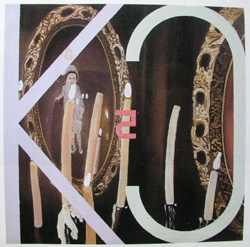
Choosing to stretch the panels in such a way as to expose the monograms is a natural. My work coming out of grad school involved a sandwich strategy of mating an underpainting (which was extremely variable, abstract or representational, following whim and curiosity) and an over painting of what began as letter forms struck over the top, finishing the work. I came to see it as a Ruscha strategy in reverse. Over time, I moved away from an opposition (repulsion perhaps of image and text?) between under and over painting, towards affinity.. a merger.
All of my older records are in Los Angeles, and this is the only image I could find here in Spain. I'll blog more about the earlier stuff when I return to SoCal this Fall.
Cousins
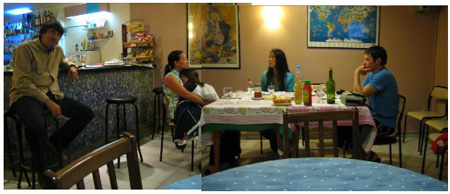
The beginning of the summer is inaugurated with a confluence of cousins. We ate at Can Soms, a down home restaurant at the base of their hostel that specializes in Tapas geared for the locals, decidedly not touristic food. In the foto above, I pull back for a panorama that includes the proprietor, Alberto. He had the city council meeting on the television (TV Tossa) and the whole time, he was cracking jokes. Alberto is a natural comic, he can just stand there and be funny. A fisherman and a nudist, he likes to combine his interests, surf casting super Costa Brava stylin'. Jusst ask him, he'll tell you all about it.
(For my hard core artworlder friends: This is a family info post. Don't click "continue". Nothing to see here. Move along now. Keep it moving.)
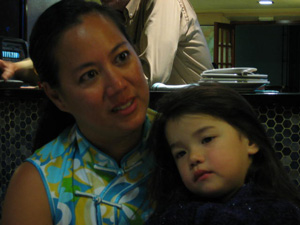
Gina and Jade. Nearly all of my mother's side of the family immigrated to Australia from Manila back in the sixties. The kids are full bore Aussies. Gina works for Nestl?, coordinating their intra-business communications via the internet (well, I barely understand her job, this is a sketch).

Gina met Alex here in Tossa, sunbathing on the beach, actually. Alex is from Tarragona (I think his Castellano accent is fantastic) and he's been acclimatizing himself to Australia very nicely. A strong creative character, he's specializing in decorative ceramic tile design. He's a painter too.
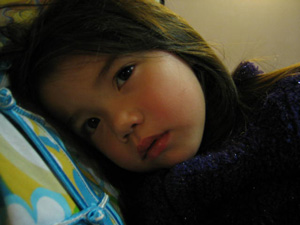
Their daughter Jade took a liking to me at first sight, the way some kids do. She was tired, a long day for her. I wished I had taken pics of her earlier, she's so beautiful. Smart too. And she doesn't seem to have inhibitions, the shyness that most kids have. And what's more, she is confident without being obnoxious, very sweet. I liked seeing Alex interact with her, an attentive father who carefully and gently stewards her learning curve. Everyone in the family is happy to have him in the fold.
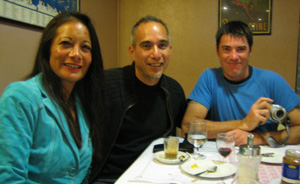
Patricia was on vacation, fresh from Kabul. She works in the international humanitarian aid field... she deserves her own blogpost... nee, a book. I'm going to have to interview her carefully so I can competently recount her story later on here in the blog. She owns an apartment here in Tossa as well. This week, she wasw nearly drafted into an assignment to work in Uganda where some "Lord Rebel Child Army" was stirring up trouble. More on her later, fascinating stuff.
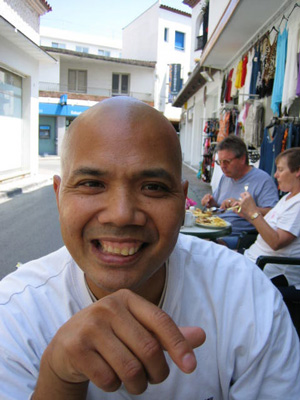
Cousin Joe couldn't make it that night, so I caught up with him for lunch the next day. He's living in Tossa, working for an English family who are property developers. He says that they are big thinkers, constantly hatching real estate schemes on scales that boggle the mind.

They are the kind of people who, when they have to travel to England, they pull the helicopter out of their hangar and off they go. ("Get out of here. No way!" I respond in disbelief.) Joe says it takes two refueling stops to get there. This detail persuades. He says that they often survey their land from their bird's eye view... and I crack jokes about celestial loudspeakers.
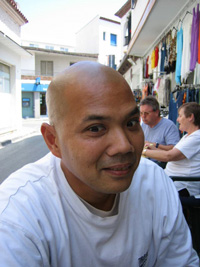
I showed off our new camera (Canon Powershot SD200 y'all). By the way, it turned out that our Nikon didn't crap out after all. (!) The batteries were shot. (heh, er... yup, feet shuffle) I tell Joe about the Tony Cu?ha advice and he gives it a try.
Well we'll have to practice it a little more.
A Stability and Clarity of Mind

A vein of gold here:
The researchers tested the experience of visual rivalry by monks during the practice of two types of meditation: a "compassion"-oriented meditation, described as a contemplation of suffering within the world combined with an emanation of loving kindness, and "one-point" meditation, described as the maintained focus of attention on a single object or thought, a focus that leads to a stability and clarity of mind.
Whereas no observable change in the rate of "visual switching" during rivalry was seen in monks practicing compassion meditation, major increases in the durations of perceptual dominance were experienced by monks practicing one-point meditation. Within this group, three monks, including two of the retreatists, reported complete visual stability during the entire five-minute meditation period. Increases in duration of perceptual dominance were also seen in monks after a period of one-point meditation.In a different test of perceptual rivalry, in this case prior to any meditation, the duration of stable perception experienced by monks averaged 4.1 seconds, compared to 2.6 seconds for meditation-na?ve control subjects. Remarkably, when instructed to actively maintain the duration, one of the retreatist monks could maintain a constant visual perception during this test for 723 seconds.
The findings suggest that processes particularly associated with one-point meditation--perhaps involving intense attentional focus and the ability to stabilize the mind--contribute to the prolonged rivalry dominance experienced by the monks. The researchers conclude from their study that individuals trained in meditation can considerably alter the normal fluctuations in conscious state that are induced by perceptual rivalry and suggest that, in combination with previous work, the new findings support the idea that perceptual rivalry can be modulated by high-level, top-down neural influences.
So I google for links of examples of perceptual rivalry. Dali surfaces again. Personally, I like to think of seeing painting as both abstraction (physical stuff in effect) and representation simultaneously. Or nearly so.
Imagine, a possible link between an art of perceptual/conceptual rivalry and "a stability and clarity of mind".
Whew.
We're in Gombrich territory, aren't we?.
June 7, 2005
June 6, 2005
You Bunch of Tossers
This will be a big month for the future of the European Union. I've got a few things that I want to assemble into a post, but the blogjam is still in effect until I get this painting wrestled to the ground (yes, I'm still wrangling). But this choice clipping from Zact Ei's blogpost is as remarkably incisive as it is forboding (I don't know how to find the specific link on his site), zondag 5 juni 2005:
Meanwhile, some people in France, Germany and Italy are talking about getting out of the euro. This is rich. France and Germany bent the eurozone budget rules into a Moebius ring; Italy should never even have been admitted. (By the way: no, you're not getting out of the euro, you bunch of tossers. You'll bloody well stay in and pay us our 10 percent back first before you even get to bring up the subject again. Then you can run with your tail between your legs, because God knows there are no balls to get in the way.)
To summarize, I'm beginning to think they were right on that whole Holocaust and World War III prediction. It's what might happen if we don't send this bunch of adolescents who are supposed to be our leaders home pronto.
Ouch. That's going to leave a mark.
(The 10 percent is what the Dutch think they've been shortchanged in the conversion to the Euro.)
No offense to my pals in the three countries indicated, current events and all that.
June 5, 2005
Admin
I'm letting the calendar slip because I've had my hands full with the latest painting. It would be nice to let you all in onthe blow by blow... pues... the task of articulating my process whilst I am in the midst of it would displace the process itself. It is best therefore to document it, post-process (blog about how the painting came about after I paint it rather than while I am in the process of painting it).
Another factor is that it is impossible for me to paint while someone accompanies me in the studio. (Well, I guess I could do that... but it would imply a totally different kind of art making, something closer to the great Kippenberger I guess -note his drawings on hotel stationary for example... but not now and not for the kind of paintings that I want to do.) Live blogging the making of a painting is a no-go at the moment. Who knows, in the future, when we can go to the Apple SuperStore and have neueral iMac implants...
But stay tuned for the proximate blowing of the blogjam:
- this "big" painting of course
- the possible/probable implosion of the Euro (!!!!!!!!!!!!!!!!!!!!!!!!!!!!!!!)
- fun timeline stuff
- my cousin Patricia's arrival in Tossa
- the June festivus in Tossa
- more highjinks with Kiko of course
- Stephanie in LA and thoughts of the SoCal/Costa Brava axis
- the impending post: "Writhing Tools"
